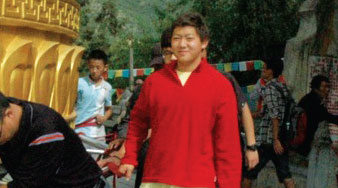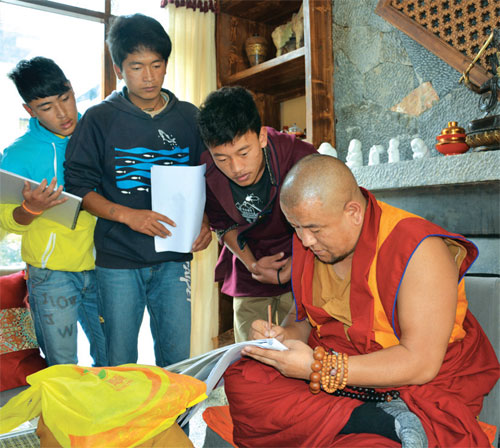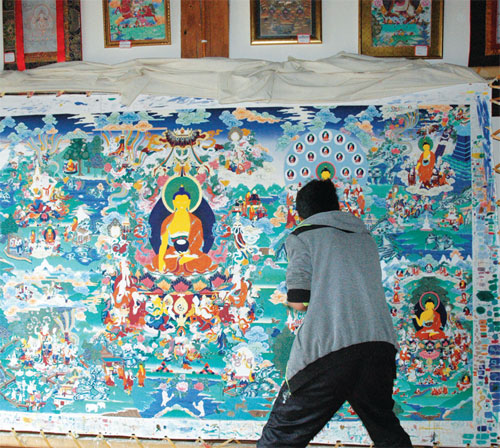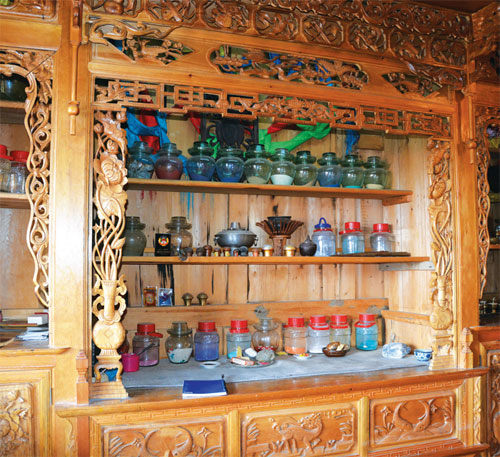Art has its reasons
Updated: 2015-04-10 08:56
(HK Edition)
|
|||||||
Editor's note: Justin Xiang, 17, grew up in Hong Kong. Fascinated by the Tibetan Thangka painting since childhood, Xiang, now a high school student in the US, took time off to volunteer with the Shangri-La Association of Cultural Preservation - an NGO based in Shangri-La, Diqing, Yunnan province, working to preserve traditional Tibetan culture and heritage through Thangka art. In this article he shares his experience which turned out to be an eye-opener.
Day 1:
I paid a visit to Master Lobsang Khedup at the Thangka Academy.
He was born in Dongwan village not far from Shangri-La. By the time he was 7, he knew he wanted to be a monk and painter. At 16, he crossed the Himalayas to study the art of Thangka and Buddhism. His leg was frozen badly during the journey through sub-zero terrain. Now he walks with a slight limp.
This morning I tried making my first Thangka - an image of the Buddha's head. The first step was to sketch the outline on a grid. Drawing a Thangka was more mathematical than I had originally thought.
I focused on the Buddha's eyes. They have to be symmetrical and convey a sense of benevolence and kindness. The teacher said my Buddha looked a bit angry. It took me more than two hours before I could bring some compassion to it.
The students at Thangka Academy are aged between 14 and 24, many from families with low incomes. They cook their own meals. I assisted the chef today. The students said they enjoyed cooking for friends. I really admire their attitude.
Day 2:
It usually takes students about 10 years to perfect their craft. Since most of them will make a career of the skills they learnt here, they want to be on solid ground before they start drawing on their own.
I practiced drawing both the right and left foot of the Buddha five times each. It's mentally exhausting. Trying to get the tiny details of the Buddha's hands, feet and eyes in perfect shape is a demanding task indeed.
Day 3:
I went hiking in the hills with the students today. The idea was to do nature study. We climbed a peak with an altitude of 3,600 meters.
Some of the students were local while others came from distant places such as Tibet and Sichuan. All except one had Tibetan roots. They sang Tibetan songs even as they were drawing. Although I didn't speak the same language, the song came across as extremely cheerful. These young people are a living proof that one can be happy even without access to the newest gizmo in the market.
In the afternoon we cleaned up the Thangka Academy. The students seemed to love this two-hour exercise. They danced and sang as they worked at it.
Day 4
Master Khedup says the difference between a good artist and a mediocre one lies in the said artist's power of observation. He developed his by observing and recording each step of plant growth several hundred times over.
Master Khedup has a young apprentice who has been following him since the age of 7. He is 12 now. He gets up at 6 am to read Buddha's teachings. The rest of the day is spent assisting the Master.
Injured animals are picked up by the academy, nursed back to sound health and set free. A hunter once auctioned a deer for 30,000 yuan. The academy and volunteers pooled the money together from selling artworks and bought the deer, which has lived at the academy ever since.
Day 5
On Sundays students spend time preparing the special paint required for Thangka art. Made from various natural ores, these are extremely expensive and never fade away.
The most interesting Thangka I have seen is that of a devil being pinned down by several famous Buddhist monasteries in Tibet. The story goes like this: there was once a devil roaming around Tibet, haunting people's lives. The only way to subdue him was by taking recourse to Buddhism. It's an obvious metaphor for the devil within, the students told me.
Day 6
Today I visited the famous Ganden Sumtseling Monastery - home to the largest "Spinning Golden Bucket" in the world. It is 35 meters tall and has a 4-meter radius. To spin it, one must hold on to an attached strap and walk around the contraption. Spinning it clockwise three times is said to bring good luck!
I found out about the Tibetans' resistance to medicine today. The students told me they preferred natural healing to strengthen their immune system rather than use medication.
Day 7
The students are grateful for having found a home at the academy. One student had been working on a garbage pickup truck since he was 7 to help provide for his family before he came here.
They are happy to be surrounded by the beautiful mountains, learning a craft they feel passionate about and being devout worshippers of the Buddha.
At Deerfield Academy in the United States, where I studied for two years, the motto is: "Be worthy of your Heritage". I hardly understood its significance until now. My Shangri-La experience made me realize it's not only important for me to be worthy of my heritage, but also help others to become worthy of theirs. This is why I intend to raise money for this cause - preserve and protect Thangka, Tibetan cultural heritage.
Sitting on a wooden stool in the rustic and dirt-covered kitchen of Thangka Academy, eating a bun made by a fellow student, I watched light rain fall on a three-storey wooden structure the students here call "home". It's certainly a different world from the one I know so far.
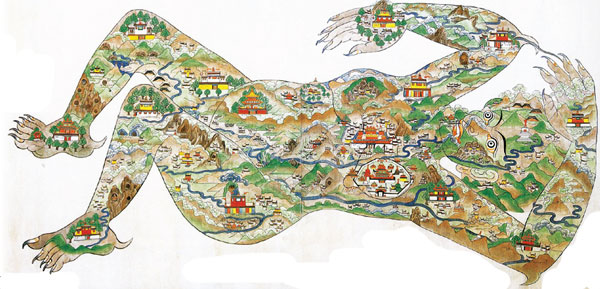
|
Justin Xiang (in red) stands next to the largest "Spinning Golden Bucket" in the world, at the Ganden Sumtseling Monastery, Shangri-La. |
|
Master Lobsang Khedup shares his insight into the art of Thangka with students at the academy. |
|
Thangka paintings feature well-known Buddhist stories, legends and folklore. |
|
The paint used is extracted from natural sources, including stones and metal. |
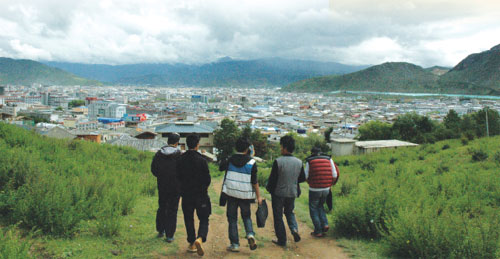
(HK Edition 04/10/2015 page9)
